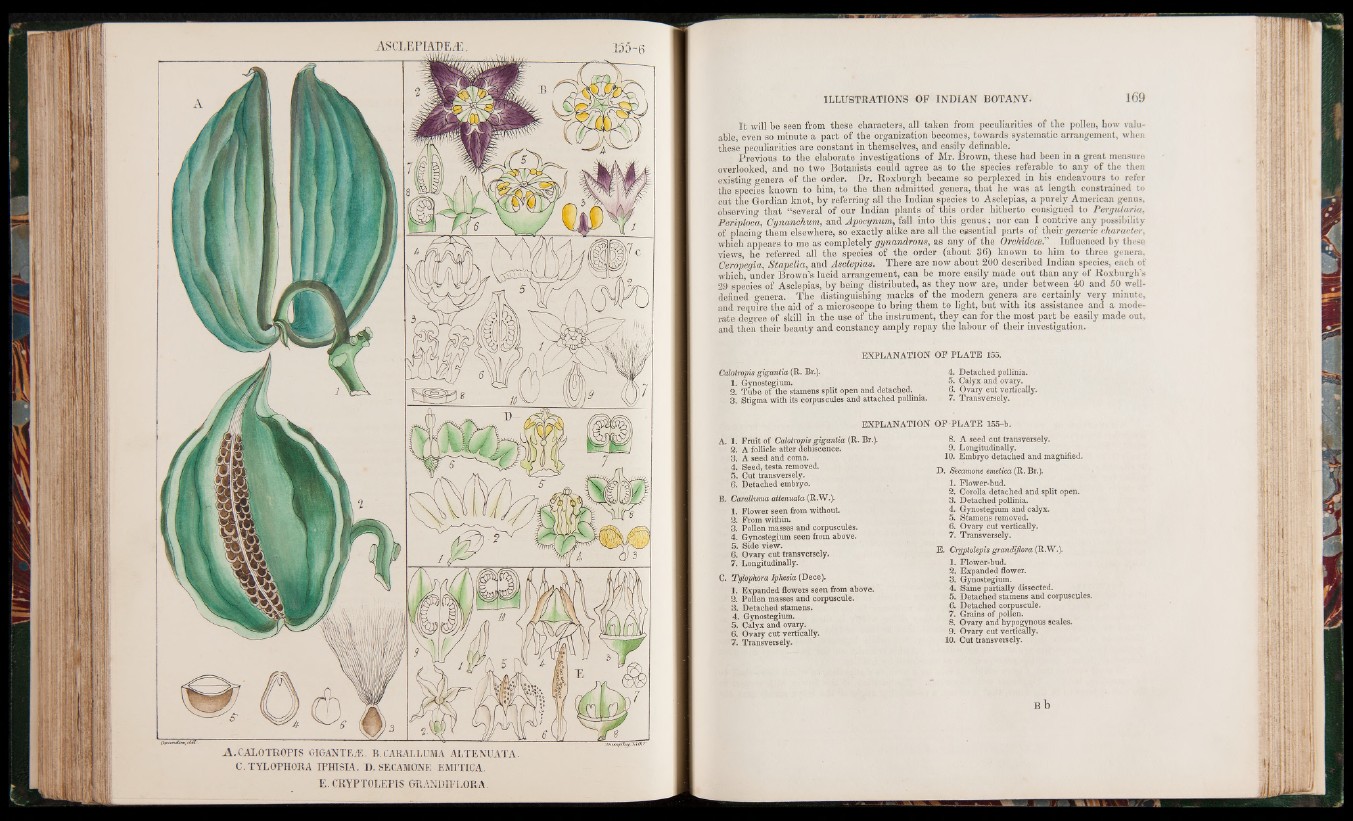
A . CALOTROPIS GIGANTEÆ. B.CARALLUMA ALTENUATA.
C. TYLOPHORA IPHISIA. D. SECAMONE EMITICA.
E . C B Y P T O L E P I S G R A N D I P L O R A .
155-6
It will be seen from these characters, all taken from peculiarities of the pollen, how valuable
even so minute a part of the organization becomes, towards systematic arrangement, when
these peculiarities are constant in themselves, and easily definable.
Previous to the elaborate investigations of Mr. Brown, these had been in a great measure
overlooked, and no two Botanists could agree as to the species referable to any of the then
existing genera of the order. Dr. Roxburgh became so perplexed in his endeavours to refer
the species known to him, to the then admitted genera, that he was at length constrained to
cut the Gordian knot, by referring all the Indian species to Asclepias, a purely American genus,
observing that “several of our Indian plants of this order hitherto consigned to Pergularia,
Periploca, Cynanchum, and Apocynum, fall into this genus; nor can I contrive any possibility
of placing them elsewhere, so exactly alike are all the essential parts of their generic character,
which appears to me as completely gynandrous, as any of the O r c h id e c e Influenced by these
views, he referred all the species of the order (about 36) known to him to three genera,
Ceropegia, Stapelia, and Asclepias. There are now about 200 described Indian species, each of
which, under Brown’s lucid arrangement, can be more easily made out than any of Roxburgh’s
29 species of Asclepias, by being distributed, as they now are, under between 40 and 50 well-
defined genera. The distinguishing marks of the modern genera are certainly very minute,
and require the aid of a microscope to bring them to light, but with its assistance and a moderate
degree of skill in the use of the instrument, they can for the most part be easily made out,
and then their beauty and constancy amply repay the labour of their investigation.
EXPLANATION OF PLATE 155.
Calotropis g ig a n tia (R. Br.). 4. Detached pollinia.
1. Gynostegium. 5. Calyx and ovary.
2. Tube of the stamens split open and detached. 6. Ovary cut vertically.
3. Stigma with its corpuscules and attached pollinia. 7. Transversely.
EXPLANATION OF PLATE 155-b.
A. 1. Fruit of Calotropis g ig a n tia (R. Br.).
2. A follicle after dehiscence.
3. A seed and coma.
4. Seed, testa removed.
5. Cut transversely.
6. Detached embryo.
B. Caralluma attenuata (R.W.).
1. Flower seen from without
2. From within.
3. Pollen masses and corpuscules.
4. Gynostegium seen from above.
5. Side view.
6. Ovary cut transversely.
7. Longitudinally.
C. Tylophora Iphesia (Dece).
1. Expanded flowers seen from above.
2. Pollen masses and corpuscule.
3. Detached stamens.
4. Gynostegium.
5. Calyx and ovary.
6. Ovary cut vertically.
7. Transversely.
8. A seed cat transversely.
9. Longitudinally.
10. Embryo detached and magnified.
D. Secamone emetica (R. Br.).
1. Flower-bud.
2. Corolla detached and split open.
3. Detached pollinia.
4. Gynostegium and calyx.
5. Stamens removed.
6. Ovary cut vertically.
7. Transversely.
E. Cryptolepis g randiflora (R.W.).
1. Flower-bud.
2. Expanded flower.
3. Gynostegium.
4. Same partially dissected.
5. Detached stamens and corpuscules.
6. Detached corpuscule.
7. Grains of pollen.
8. Ovary and hypogynous scales.
9. Ovary cut vertically.
10. Cut transversely.
B b